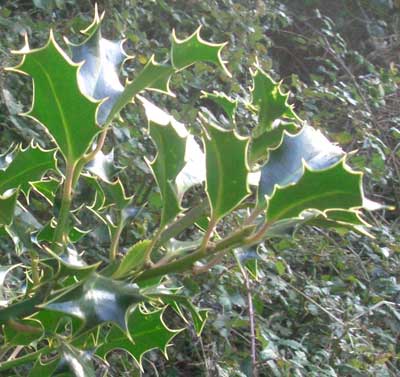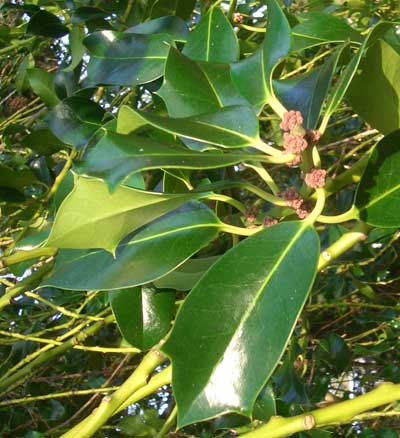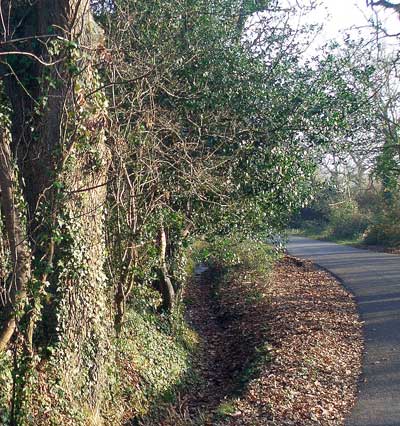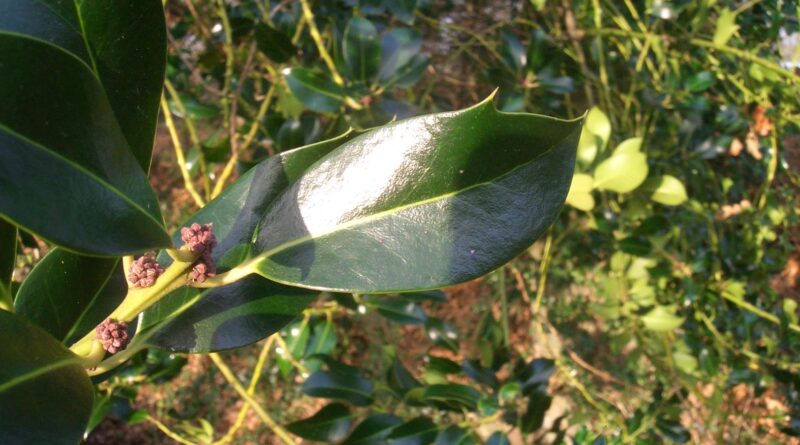The prickly question of holly leaves
- Complaining about the Mainland - 17th August, 2024
- New island designation – is it just greenwash? - 26th April, 2024
- Police and Crime Commissioners – a solution or a problem? - 21st April, 2024
There’s nothing like the possible debunking of ‘a well-known fact’ to get The Ranger’s nose twitching. Recently I went for a visit to the mainland and spent a day enjoying the delights of Lymington. This lovely coastal town is on the edge of the New Forest, and as we walked through the old leafy lanes down to the sea it was no surprise to see the typical New Forest oaks lining the banks. Alongside, as is often found in the oldest of oak woods, was holly.

Holly is able to grow in places where there is not much light, so often does well under old trees, such as in the New Forest. I noticed however that some of these holly trees were remarkably un-spiny. In fact many of the leaves had but one or two spines on them. I remembered the generally-recounted explanation for this: the smoother leaves are higher up the tree, where the spines are not needed for protection against browsing animals. But these holly trees had some smooth leaves at ground level – and some spiny leaves higher up! There seemed to be no direct connection between spininess and height. What was going on?

This observation brought to mind a niggle that has been lodged at the back of my mind for many years. The common explanation about the browsing animals suggests that holly trees have evolved to have spiny leaves nearer the ground, to deter grazing. This really doesn’t seem to be very good: if you look at an actual holly tree the distribution of spiny leaves has never seemed to fit with the hypothesis. It also poses the question of how a leaf on a branch can ‘know’ how high it is off the ground.
At this point it’s worth pointing out that planted garden varieties of holly aren’t really in the running here – obviously if they’ve been bred for ornamental purposes this kind of subtlety will be hard to detect. Indeed most garden holly seems to be spiny all over in my own experience of it. It is only where holly is growing as a native and established plant that these smooth leaves seem to be found. And when they are, as in the hedges of Lymington, they are often found alongside spiny leaves, and at various heights. Certainly there is no absolute high-low distinction.
So does this mean the browsing theory is completely wrong? Well, no it doesn’t as it turns out. However to fully explain the erratic spine distribution a little more detail is required. There have been a number of scientific papers looking into this question. Going back t0 Potter and Kimmerer (1988) these US researchers looked at both mammals and insects browsing on American holly. They found, perhaps unsurprisingly, that insect predators didn’t care whether the leaves were spiny or not. Perhaps more unexpectedly, the bigger mammals didn’t either. They also compared height of leaves, size of trees, and spininess. They reported:
Leaves on lower branches of mature forest trees were slightly more spinescent than were upper leaves, and juvenile trees were slightly more spinescent than were mature trees. However, there was no relationship between degree of spinescence and feeding damage.
It would probably be worth reading that aloud just to enjoy saying ‘spinescence’. Once over that pleasure, the unexpected conclusion from this paper is that in American forests at least, the theory of height-related spines on holly does not seem to be clearly supported by Potter and Kimmerer’s work. So maybe something else is at work here.

Working on European holly, Obeso (1997) sheds some light on the issue. Professor Obeso found evidence – contrary to the 1988 American study – that spinier leaves did actually deter browsing by large mammals. He also suggested how this spininess was caused. He found that bigger leaves had fewer spines, which he suggested meant that when a plant had its leaves nibbled, the regrowing leaves could be smaller and thus spinier. So maybe the spinescence of the leaves is connected to how old they are. This would explain why the non-spiny leaves are sometimes found at lower levels, as they have not been grazed and so are older.
In 2012, Herrera and Bazaga (studying Spanish holly again) found a mechanism to explain how this happens at a molecular level. They particularly looked at the question of whether or not browsing by large mammals was the cause, or leaf height, and concluded that the animals were to blame.
Ungulate damage, rather than the bottom height of the crown, was therefore the best single predictor of variation among trees in the proportion of branchlets with prickly leaves.
Finally there was an explanation: spinescence is not some inherited trait linked strictly to height, or leaf age, but is a local and variable response to browsing (or maybe trimming, if in a garden).
Leaf height on a tree is easy and quick to measure – and there are countless school science projects suggesting that children should record spines on holly trees and correlate these with height. But the research suggests that the true situation is more complex than is often presented. Although in many cases the relationship between spines and height will appear to be simple, it is not. If spinescence is a response to damage, a holly tree that is never browsed or pruned may have relatively few spines across its height. By contrast one that is evenly damaged across its whole height (like maybe some regularly trimmed trees in school grounds) would show many spines at all heights. I guess there’s an experiment there for anyone with the patience to grow enough holly and prune it accordingly, but it does seem as though the simpler and quicker experiment the school students are offered might need to be updated a bit.
It is often the case that holly has spinier leaves lower down. That much is clear. But sometimes it does not. Why? Because the trees respond to damage by producing spines – not because of the height. Damage is more common lower down, so spines too are more common lower down. This damage-related theory of spinescence (see, I said it too, and with a straight face) explains the Lymington holly I saw, and suggests an explanation of why holly does not actually show a simple distribution of spines relative to leaf height. Holly in the Lymington lanes (where the New Forest ponies don’t go) would rarely if ever be browsed, and so could grow big and smooth leaves. And in gardens – and school grounds – where there may be little or no browsing, the phenomenon is much less noticeable. See, there was a simple explanation after all. And we got to say ‘spinescence’.


Just wondering how long holly has been around. Was it around before or same time as the dinosaurs, in which case wouldn’t the larger mammals have been able to reach the high leaves as well?
I have a large male and a small female holly trees in my yard. A beautiful little baby squirrel who is very affectionate and friendly taught me something valuable today. I been watching him learning to climb the male tree near his nest. Today I saw him quite high up picking and eating the leaves! I asked Alexa and evidently holly leaves can be quite high in calcium. Calcium is very important, especially to growing baby squirrels.
I mentioned Alexa since I have been trying to confirm that fact online and came across your site. I’ll be interested to check the points on the leaves higher up in the tree, but Pikachu seemed to be having a good time with his snack.
Sitting in the garden lioking at a holly tree prompted me to search why the leaves were not always prickly. Who knew how many had also asked this question and researched it? Thank you – I ❤️ this article and also the word spiniscence.
Pingback: A Spring Walk in Bluebell Wood | Bug Woman – Adventures in London
Similar to spinescence is marescence, one of my favorite botanical antibrowsing adaptations. And i love the color of young marescent beech sapling leaves in winter.
hi, a very interesting read. i am doing a report on this and it would be great if anyone else has done one before or could help me out? a scientific report being one with an
Introduction
Methods
Results
Discussion
and all with good References, all this would really help me out. thank you and merry christmas and happy new year. jason
He’s quite hot, actually (even in Antarctica).
Spinescence is my new favourite word and I suppose “prickly” isn’t scientific enough. Professor Obeso sounds like a portly, evil mastermind from a comic book!
Spinescence’?
‘Professor Obeso’?
Despite these, thanks for an interesting investigation which I’ll remember next time I’m in the nearby holly wood.
I prune a good bit of Holly here in Alabama…there are different varieties… some I have cut back that have the prickly leaf the moment it grows back it’s already in that shape, so no animal could have grazed on it. There’s another variety that also grows as a hedge.. it too grows with a lobed leaf from the bottom of the plant to the top. The leaf shape doesn’t change. What’s amazing to me is that the darker greed the leaf the harder the spine. When it’s new growth you can grab the new growth without gloves and the new growth never pricks you.
Poor old Prof. Obeso! He does sound a bit like a super-hero’s nemesis, and I’m not surprised nobody seems to believe in him… but actually he really is a Spanish academic and neither sinister nor obese!